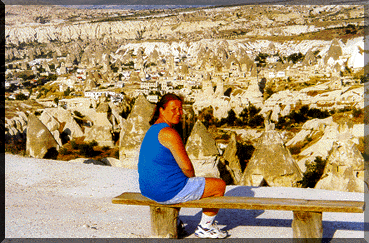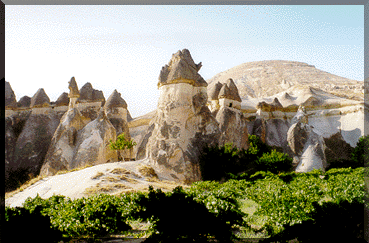The ancient region of Cappadocia (Kapadokya in Turkish) is located in central Anatolia between the cities of Nevsehir, Nigde and Kayseri. Millions of years ago violent eruptions of the volcanoes Mt. Erciyes and Mt. Hasan covered the surrounding plateau with tuff. Wind and weather have eroded the soft volcanic rock into hundreds of strangely shaped pillars, cones and "fairy chimneys", in colors ranging from pink to green and yellow.
From the ancient times, men have hallowed out these soft rocks, and they have made cuntless cave churches, chapels and monastries.
The churches are from the early Christianity. The art style of the churches can be classified into two categories: the 8th and 9th century are the iconoclastic years - the 10th to the 13th centuries whose decorations represent the lives of Christ and various Saints. The architectural plans of the churches are uncomplicated.
Goreme and Urgup are two lively tourist centers. There are cave dwellings, as well as the rock cones in and around these cities. Avanos, on the banks of Kizilirmak river and Ortahisar are less visited towns.
Superb views of the Cappadocia valley can be seen from the castle located in Uchisar.
Goreme Open Air Museum is a complex of churches and chapels, dating back to 10th century. There are great frescoes in many, Yilanli Church, Tokali Church are among the most important.
Zelve is one the most impressing valleys in the region offering a more disorganised and rough hike.
Also there are a number of underground cities used by Christians hiding from enemies. There were rooms for grain storage, sleeping chambers, kitchens and ventilation shafts.
Underground cities of Kaymakli and Derinkuyu are the two most important. There are also two others named Mazi and Ozkaynak.
Cappadocia is an important area for shopping, with wonderful carpets and kilims and very local wines. It is also a great region for trekking and the scenery is wonderful in all seasons for photograph taking.



